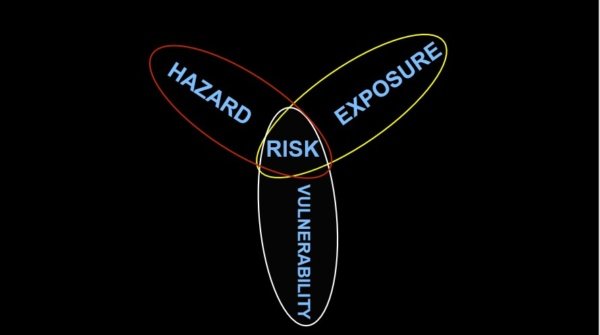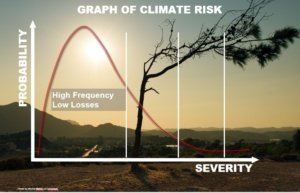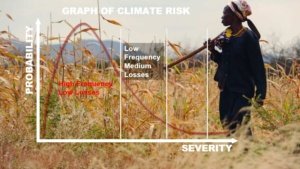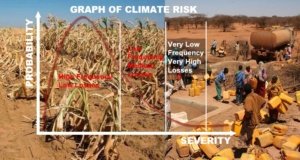Climate risk refers to the formal assessment of the consequences, likelihoods, and responses to the impacts of climate change, as well as how societal constraints shape adaptation options. As climate-related threats continue to intensify, understanding climate risk is essential for developing strategies to protect communities, ecosystems, and economies.
Components of Climate Risk

To properly assess climate risk, we must examine its three key components: Hazard, Exposure, and Vulnerability. Each of these factors determines whether an event or trend poses a significant threat to people and the environment.
1. Hazard
A climate hazard refers to a physical process or event, such as hydro-meteorological or oceanographic phenomena, that has the potential to harm human health, livelihoods, or natural resources. Without the presence of a climate hazard, risk does not exist.
For instance, changes in precipitation levels, whether in total amount or distribution over weeks or months, can pose risks to agriculture, water availability, and urban infrastructure. Similarly, extreme weather events like hurricanes, heat waves, and floods can have devastating effects.
2. Exposure
Exposure signifies the degree to which certain regions, sectors, ecosystems, and social groups are affected by climate change. If a community or system is not exposed to climate-related threats, risk is minimized.
For example, severe storms in the open ocean away from shipping routes and coastal communities do not pose a direct risk since humans, properties, and biodiversity are not exposed to them. In contrast, similar storms on land can lead to destruction, displacement, and long-term economic consequences.
3. Vulnerability
Vulnerability reflects how susceptible a system is to climate change impacts and how effectively it can adapt. Some groups or sectors have stronger resilience mechanisms, while others struggle to cope.
Consider farmers facing drought conditions: those with advanced irrigation systems and technology can respond effectively and maintain productivity. On the other hand, subsistence farmers with limited resources may struggle to adapt, increasing their vulnerability to climate-related disasters.
If a system has the ability to recover quickly, climate risk is reduced. Conversely, when vulnerability is high and adaptation measures are lacking, climate risk is exacerbated.
You may also read: https://eefabecanada.org/digging-deeper-why-climate-justice-starts-with-how-we-mine/
Types of Climate Risks
Climate risks differ not only in how likely they are to occur but also in how severe their consequences may be.
High-Frequency, Low-Severity Risks
These risks occur frequently but cause minimal disruption. Planned adaptation measures can effectively mitigate their impacts. Examples include gradual changes in seasonal rainfall patterns and rising temperatures.

Low-Frequency, Medium-Loss Risks
These events are less common but cause moderate losses. One example is prolonged dry spells during crucial agricultural periods, which can lead to significant crop failures. Parts of Africa have witnessed entire growing seasons collapse due to irregular rainfall patterns.

Very Low Frequency, Very High Loss Risks
These events are rare but catastrophic when they do occur. For instance, multi-year droughts can lead to widespread agricultural collapse, food shortages, economic decline, and forced migration. The prolonged failure of essential climate conditions can destabilize economies and threaten human survival.

The Role of Adaptation
Given the increasing frequency and severity of climate risks, adaptation is more critical than ever. Adaptation refers to the proactive planning and implementation of strategies to protect people and ecosystems from adverse climate impacts. The Intergovernmental Panel on Climate Change (IPCC) defines adaptation as measures that enhance resilience while reducing vulnerability.
This means societies must develop climate-resilient infrastructure, promote sustainable resource management, and invest in early warning systems to prevent large-scale disasters. By strengthening adaptive capacity, communities can lessen the effects of climate variability and ensure a more sustainable future.
Conclusion
Climate risk is not uniform; its impact varies depending on the level of hazard, exposure, and vulnerability. While some risks can be anticipated and managed, others can lead to disastrous consequences if ignored. To safeguard ecosystems, economies, and human well-being, we must prioritize climate adaptation and resilience-building efforts.
The time for action is now. Governments, industries, and individuals must collaborate to implement sustainable solutions, ensuring we are prepared for an uncertain climate future.
Related Source: https://www.eefabecameroon.org/understanding-climate-risk-in-the-context-of-climate-change/
Share this Post


